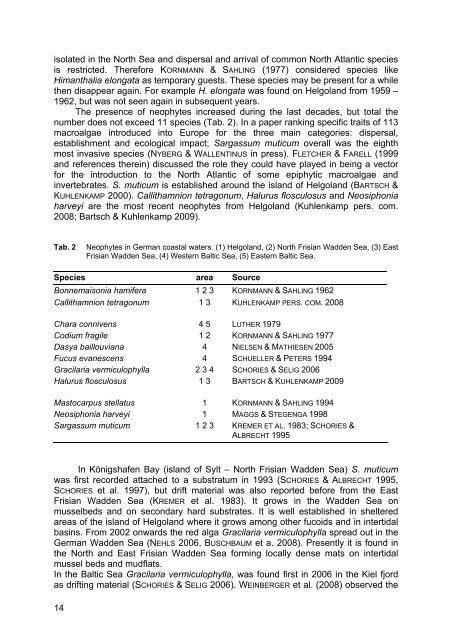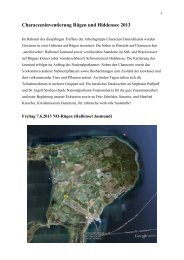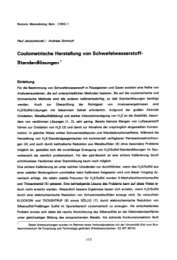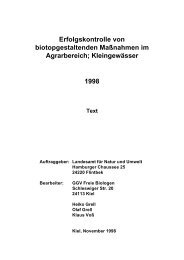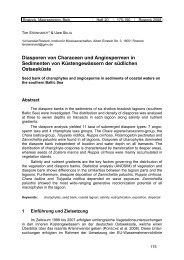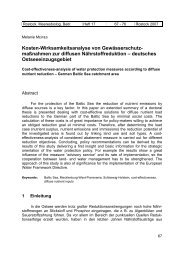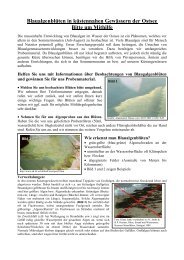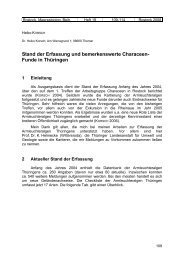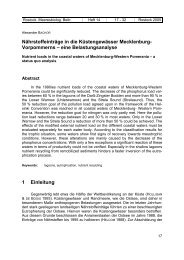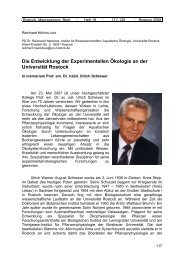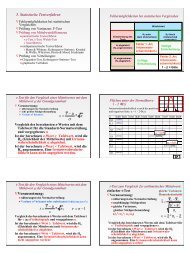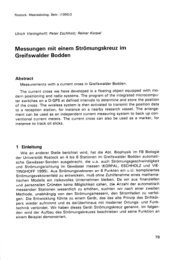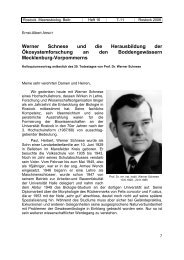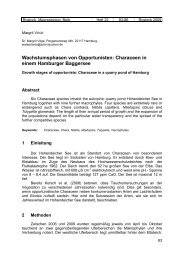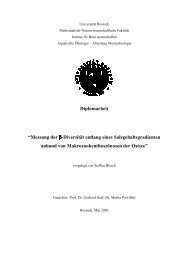Species and synonym list of the German marine - Institut für ...
Species and synonym list of the German marine - Institut für ...
Species and synonym list of the German marine - Institut für ...
Create successful ePaper yourself
Turn your PDF publications into a flip-book with our unique Google optimized e-Paper software.
isolated in <strong>the</strong> North Sea <strong>and</strong> dispersal <strong>and</strong> arrival <strong>of</strong> common North Atlantic species<br />
is restricted. Therefore KORNMANN & SAHLING (1977) considered species like<br />
Himanthalia elongata as temporary guests. These species may be present for a while<br />
<strong>the</strong>n disappear again. For example H. elongata was found on Helgol<strong>and</strong> from 1959 –<br />
1962, but was not seen again in subsequent years.<br />
The presence <strong>of</strong> neophytes increased during <strong>the</strong> last decades, but total <strong>the</strong><br />
number does not exceed 11 species (Tab. 2). In a paper ranking specific traits <strong>of</strong> 113<br />
macroalgae introduced into Europe for <strong>the</strong> three main categories: dispersal,<br />
establishment <strong>and</strong> ecological impact; Sargassum muticum overall was <strong>the</strong> eighth<br />
most invasive species (NYBERG & WALLENTINUS in press). FLETCHER & FARELL (1999<br />
<strong>and</strong> references <strong>the</strong>rein) discussed <strong>the</strong> role <strong>the</strong>y could have played in being a vector<br />
for <strong>the</strong> introduction to <strong>the</strong> North Atlantic <strong>of</strong> some epiphytic macroalgae <strong>and</strong><br />
invertebrates. S. muticum is established around <strong>the</strong> isl<strong>and</strong> <strong>of</strong> Helgol<strong>and</strong> (BARTSCH &<br />
KUHLENKAMP 2000). Callithamnion tetragonum, Halurus flosculosus <strong>and</strong> Neosiphonia<br />
harveyi are <strong>the</strong> most recent neophytes from Helgol<strong>and</strong> (Kuhlenkamp pers. com.<br />
2008; Bartsch & Kuhlenkamp 2009).<br />
Tab. 2 Neophytes in <strong>German</strong> coastal waters. (1) Helgol<strong>and</strong>, (2) North Frisian Wadden Sea, (3) East<br />
Frisian Wadden Sea, (4) Western Baltic Sea, (5) Eastern Baltic Sea.<br />
<strong>Species</strong> area Source<br />
Bonnemaisonia hamifera 1 2 3 KORNMANN & SAHLING 1962<br />
Callithamnion tetragonum 1 3 KUHLENKAMP PERS. COM. 2008<br />
Chara connivens 4 5 LUTHER 1979<br />
Codium fragile 1 2 KORNMANN & SAHLING 1977<br />
Dasya baillouviana 4 NIELSEN & MATHIESEN 2005<br />
Fucus evanescens 4 SCHUELLER & PETERS 1994<br />
Gracilaria vermiculophylla 2 3 4 SCHORIES & SELIG 2006<br />
Halurus flosculosus 1 3 BARTSCH & KUHLENKAMP 2009<br />
Mastocarpus stellatus 1 KORNMANN & SAHLING 1994<br />
Neosiphonia harveyi 1 MAGGS & STEGENGA 1998<br />
Sargassum muticum 1 2 3 KREMER ET AL. 1983; SCHORIES &<br />
ALBRECHT 1995<br />
In Königshafen Bay (isl<strong>and</strong> <strong>of</strong> Sylt – North Frisian Wadden Sea) S. muticum<br />
was first recorded attached to a substratum in 1993 (SCHORIES & ALBRECHT 1995,<br />
SCHORIES et al. 1997), but drift material was also reported before from <strong>the</strong> East<br />
Frisian Wadden Sea (KREMER et al. 1983). It grows in <strong>the</strong> Wadden Sea on<br />
musselbeds <strong>and</strong> on secondary hard substrates. It is well established in sheltered<br />
areas <strong>of</strong> <strong>the</strong> isl<strong>and</strong> <strong>of</strong> Helgol<strong>and</strong> where it grows among o<strong>the</strong>r fucoids <strong>and</strong> in intertidal<br />
basins. From 2002 onwards <strong>the</strong> red alga Gracilaria vermiculophylla spread out in <strong>the</strong><br />
<strong>German</strong> Wadden Sea (NEHLS 2006, BUSCHBAUM et a. 2008). Presently it is found in<br />
<strong>the</strong> North <strong>and</strong> East Frisian Wadden Sea forming locally dense mats on intertidal<br />
mussel beds <strong>and</strong> mudflats.<br />
In <strong>the</strong> Baltic Sea Gracilaria vermiculophylla, was found first in 2006 in <strong>the</strong> Kiel fjord<br />
as drifting material (SCHORIES & SELIG 2006). WEINBERGER et al. (2008) observed <strong>the</strong><br />
14


